Street Food 3 - Soup
Speak of the devil and he will appear.
And give us Street Food Soup 🙄
When it comes to French Onion Soup, as Anthony Bourdain observed in his eponymous Les Halles Cookbook, where I used to have lunch when I lived in Manhattan:
Raymond Blanc, named after the colour of onion flesh, has even more to say in his Simple French Cookery:
Pink Roscoff or Rose de Roscoff onions are the renowned, and registered, produce of the town of Roscoff in Brittany on the Northern coast of France.
Small, round, pink- or copper-skinned, and famed for their sweet fragrance and mild sugary flesh, the seeds of this variety were brought to the region from Portugal in the 17th Century by an itinerant capuchin monkey having particularly enjoyed their taste during his holiday there.
Or it may have been a Capuchin Monk. The records are unclear.
Due to the relative difficulty of journeying to the Onion Markets of Paris and the stiff local competition there, the Bretons began shipping their onions across the Channel to England and Wales in the early 20th Century.
This trade peaked in the 1920s, made most memorable by the travelling salesmen known as Onion Johnnies who bicycled around the countryside festooned with great garlands of Pink Roscoffs, like mutant Hawaiian Leis, dressed in their traditional comedy Breton costume of a burglar's stripy shirt and a beret.
White onions, or small British yellow varieties make a reasonable substitute for the preferred Roscoffs, which are quite hard to find these days.
Onions which are larger and more Spanish are derided by professional soup makers as tasteless, anaemic and lacking in acidity.
We used Spanish onions the size of a baby's head.
We have, in fact, made French Onion Soup in these classes before, under Aaron Bulging's instruction, but I have to say that I preferred this approach with a long slow caramelization and distinct lack of flour.
Or I would have, if we'd had enough time to do it justice.
This week's PaulPointers™:
When it comes to French Onion Soup, as Anthony Bourdain observed in his eponymous Les Halles Cookbook, where I used to have lunch when I lived in Manhattan:
Onion soup, unsurprisingly, is all about the onions. Make damn sure the onions are a nice, dark, even brown color.
I'm pretty sure he means after the cooking 😉Raymond Blanc, named after the colour of onion flesh, has even more to say in his Simple French Cookery:
The quality of the onions is crucial in this recipe. We want both high acidity and high sugar levels to create a fully flavoured soup. The best onions are Pink Roscoff
Pink Roscoff or Rose de Roscoff onions are the renowned, and registered, produce of the town of Roscoff in Brittany on the Northern coast of France.
Small, round, pink- or copper-skinned, and famed for their sweet fragrance and mild sugary flesh, the seeds of this variety were brought to the region from Portugal in the 17th Century by an itinerant capuchin monkey having particularly enjoyed their taste during his holiday there.
Or it may have been a Capuchin Monk. The records are unclear.
Due to the relative difficulty of journeying to the Onion Markets of Paris and the stiff local competition there, the Bretons began shipping their onions across the Channel to England and Wales in the early 20th Century.
This trade peaked in the 1920s, made most memorable by the travelling salesmen known as Onion Johnnies who bicycled around the countryside festooned with great garlands of Pink Roscoffs, like mutant Hawaiian Leis, dressed in their traditional comedy Breton costume of a burglar's stripy shirt and a beret.
White onions, or small British yellow varieties make a reasonable substitute for the preferred Roscoffs, which are quite hard to find these days.
Onions which are larger and more Spanish are derided by professional soup makers as tasteless, anaemic and lacking in acidity.
We used Spanish onions the size of a baby's head.
We have, in fact, made French Onion Soup in these classes before, under Aaron Bulging's instruction, but I have to say that I preferred this approach with a long slow caramelization and distinct lack of flour.
Or I would have, if we'd had enough time to do it justice.
This week's PaulPointers™:
- When transporting your soup home: To more easily fill a (large) plastic soup bag, pack it into a jug first! Simple. Genius.
- If you rub a cut clove of garlic round a serving bowl, over the surface of a crouton or slice of bread, or under your arms, if you're French you can add a delicate garlicky fragrance to your salad or sandwich.
- You can slow-roast the onions for French onion soup in a very low oven overnight to get the perfect caramelisation with little effort.
- You can slow-roast roughly chopped aubergine half-covered in a low oven the same way to reduce it almost to a jam.
Dress it with olive oil, tomato purée, a drizzle of honey maybe added later?, a squirt of lime juice seemed odd to me added whilst cooking, but Paul was insistent and perhaps a little cumin and chilli.
Occasionally stir and moisten with lime juice, water or oil as needed.
Flavour with herbs and lime/lemon juice to finish. - Don't throw all? your herbs into the soup at the beginning - you'll cook off all their characteristic but more volatile essence.
Simply infuse the soup with them at the end and remove them before serving.
Though I think it's less messy to infuse a little hot water or stock to strain in at the end.
menu
Soup's Up!
French Onion Soup
French Onion Soup
The Crying Game!
French Crouton
Juste une Baguettelle.
French Cheese
Preferably Gruyère. Though lesser cheeses are available.
French Onion Soup
soup
As ever Teacher Paul is somewhat vague on the quantities - though not on the method.
You'll need enough rich stock to generously cover the onions - remember it's a soup not a stew.
I sliced 4 absolutely massive Spanish onions, added about ⅓-½ a bottle of red wine (it's all a bit hazy - but then I did drink the rest)
and made stock from 2-3 heaping tablespoons of bouillon paste, to produce about 8 crocks of soup.
Delicious soup!
You'll need enough rich stock to generously cover the onions - remember it's a soup not a stew.
I sliced 4 absolutely massive Spanish onions, added about ⅓-½ a bottle of red wine (it's all a bit hazy - but then I did drink the rest)
and made stock from 2-3 heaping tablespoons of bouillon paste, to produce about 8 crocks of soup.
Delicious soup!
Ingredients
- onions, lots and lots of onions
- butter, preferably clarified
- garlic
- stock, preferably beef
- red wine
- cognac
- thyme
- bay leaves
- brown sugar optional
- salt & black pepper
To Finish:- baguette, sliced
- Gruyère or other strong melty cheese, grated
- a little cream
- parsley or chives
First slice the onions, evenly and fairly thinly with the grain - so from tip to root: Cut the onion in half vertically, cut off the tip and root, remove the peel, and slice.
Cook over a medium progressing to low heat for a good few hours, stirring occasionally but not too often, until the onions are uniformly darkly caramelized, but not burned.
We went with red wine. Reduce this by half or two-thirds to cook off the alcohol and mellow the flavour.
Meanwhile prepare your croutons:
Fry baguette slices gently on both sides in butter or clarified butter, with a clove of garlic and a few herbs if you like but avoid burning them.
Turn them over when they are nicely browned and look like toast.
Put them on an oven tray and cover them with grated cheese. Stick them under a salamander or grill until the cheese melts, and remove.
Now to infuse some herbaceous flavours into the soup - you can muddle some herbs - thyme, rosemary, bay - into the soup for a few minutes and fish them out later.
Ladle the soup into ovenproof bowls, making sure to get a good mix of onion and liquid, place a cheesed crouton on top of each and cover the surface with more grated cheese.
Serve scalding hot to unwary customers.
It can be easiest to do this in stages - pull out the onion core and slice that, split the remaining layers if they're very thick and slice those.
Run your fingers through the finished pile to separate them all out a bit.
Do not be afraid of having too much onion - they'll reduce practically to nothing. I started with an enormous panful of sliced onion, and ended up with only about 3 cups of allium porridge.
Heat a generous amount of clarified butter in a large pan and add the onions with a little salt to help extract their moisture.Cook over a medium progressing to low heat for a good few hours, stirring occasionally but not too often, until the onions are uniformly darkly caramelized, but not burned.
This might take 4 hours,
(Thomas Keller
of French Laundry fame says 5 hours) but you should spend at least a couple of hours on it.
I like to add a splash of boiling water every time the bottom of the pan turns worryingly dark and stir that back in to the onions.
But you don't want to move them around too often - they need to sit and brown for a while. Maybe give 'em a stir every 15 minutes: It's a delicate balance!
It's easier to just stick them in a very low oven overnight with a loose foil covering.
This worked for my oven at Gas Mark S which is just below 100°C.
At Gas Mark ½ (120°C) you might need to stir them occasionally.
Towards the end of the cooking process add a few cloves of finely sliced garlic, and a little brown sugar if you like.
I like to add a splash of boiling water every time the bottom of the pan turns worryingly dark and stir that back in to the onions.
But you don't want to move them around too often - they need to sit and brown for a while. Maybe give 'em a stir every 15 minutes: It's a delicate balance!
It's easier to just stick them in a very low oven overnight with a loose foil covering.
This worked for my oven at Gas Mark S which is just below 100°C.
At Gas Mark ½ (120°C) you might need to stir them occasionally.
I prefer not to add the garlic too early as it may burn and turn bitter.
Now deglaze the pan with whatever alcohol you fancy - even a splash of vinegar.We went with red wine. Reduce this by half or two-thirds to cook off the alcohol and mellow the flavour.
Cognac, or sherry are popular deglazers, followed by white or, in our case, red wine. Even vermouth.
In interesting alternative approach being calvados and cider.
You could also add a splash of red wine, sherry or balsamic vinegar.
Just make sure to cook them all off before continuing.
Next add stock and simmer for a few tens of minutes.
In interesting alternative approach being calvados and cider.
You could also add a splash of red wine, sherry or balsamic vinegar.
Just make sure to cook them all off before continuing.
Ideally you would have freshly home-made beef stock to use, but you could also use chicken.
We had a pretty decent chicken bouillon paste and some powdered beef bouillon which I mixed together.
We had a pretty decent chicken bouillon paste and some powdered beef bouillon which I mixed together.
Meanwhile prepare your croutons:
Fry baguette slices gently on both sides in butter or clarified butter, with a clove of garlic and a few herbs if you like but avoid burning them.
Turn them over when they are nicely browned and look like toast.
Put them on an oven tray and cover them with grated cheese. Stick them under a salamander or grill until the cheese melts, and remove.
Gruyère is the classic French Onion topping, but Paul suggests Norwegian Jarlsberg as a reasonable alternative. I recommend Comté.
Now to infuse some herbaceous flavours into the soup - you can muddle some herbs - thyme, rosemary, bay - into the soup for a few minutes and fish them out later.
Or as I prefer, make the soup slightly thicker than you want to serve, and steep some extra hot stock or boiling water to infuse with the fresh herbs for a while,
before straining this into the soup at the last minute, diluting it down to just the right consistency.
Add a grinding of pepper and adjust the seasoning at this final stage - you won't know earlier how much salt the stock may have added.Ladle the soup into ovenproof bowls, making sure to get a good mix of onion and liquid, place a cheesed crouton on top of each and cover the surface with more grated cheese.
Paul also likes to add a dollop of clarified butter, a drizzle of double cream and a scattering of chopped parsley on top at this stage.
Put the bowls back under the grill and blast them until the cheese darkens in spots and melts everywhere.
Yesterday I poured a puddle of cream under the crouton, and it for whatever reason it was especially delicious. Coincidence?
You could equally sprinkle over chopped chives or thyme leaves. Though I rather like a drizzle of truffle oil.
Serve scalding hot to unwary customers.
Thick, rich, beautiful. I think I want to marry it 🤣
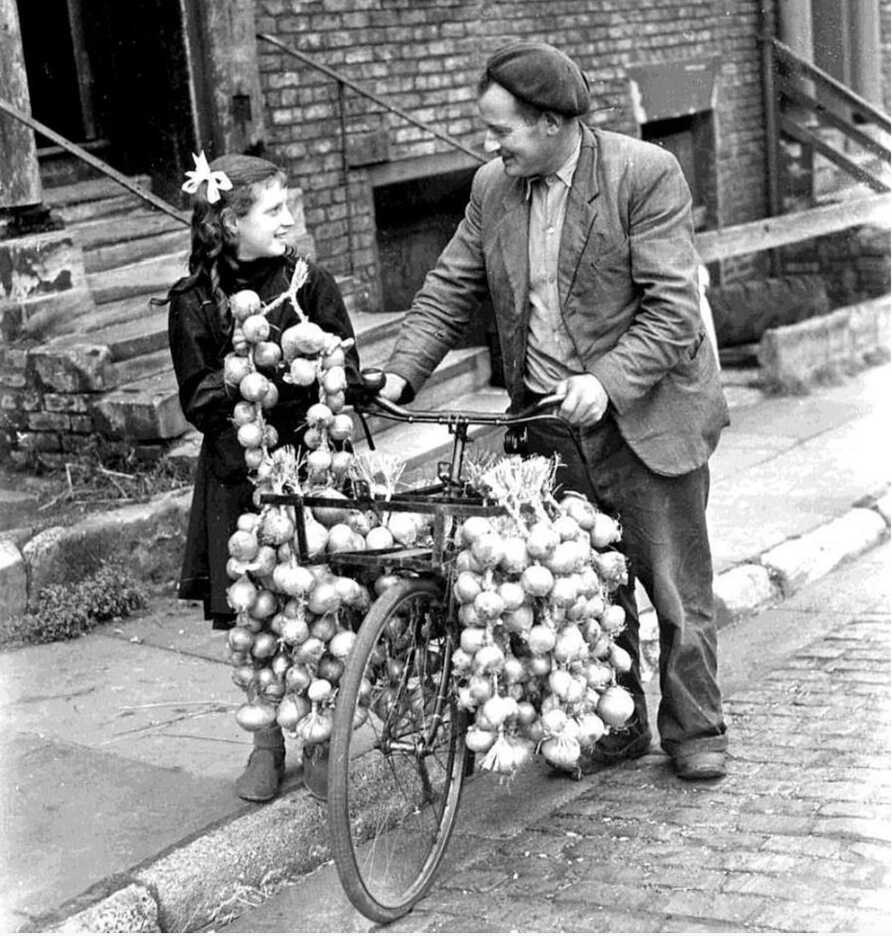
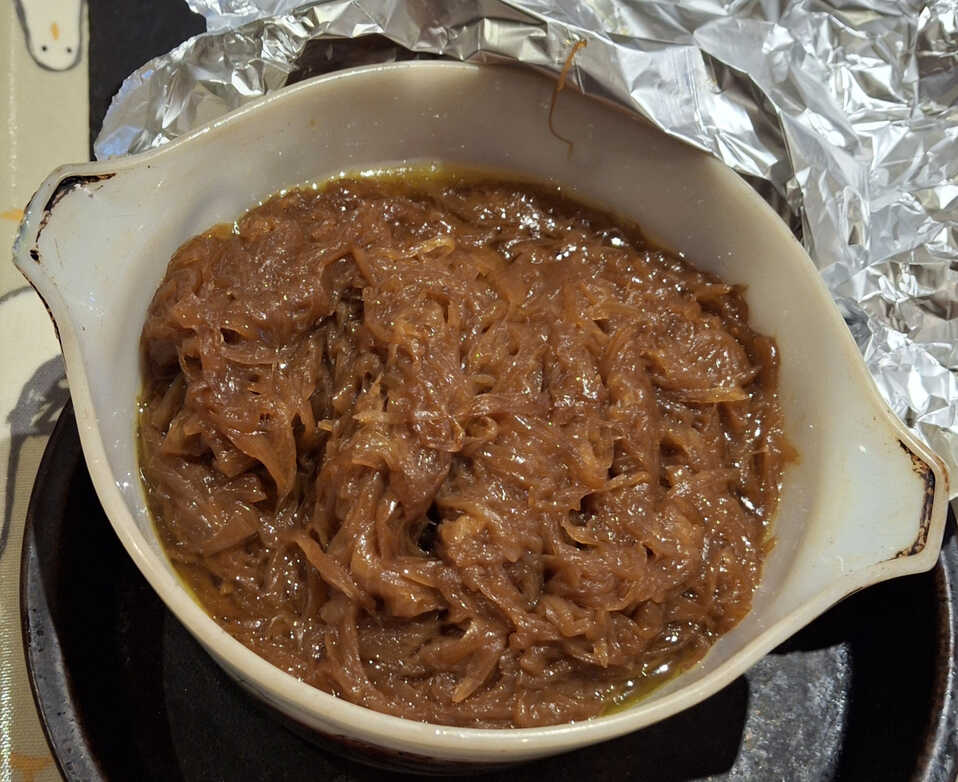
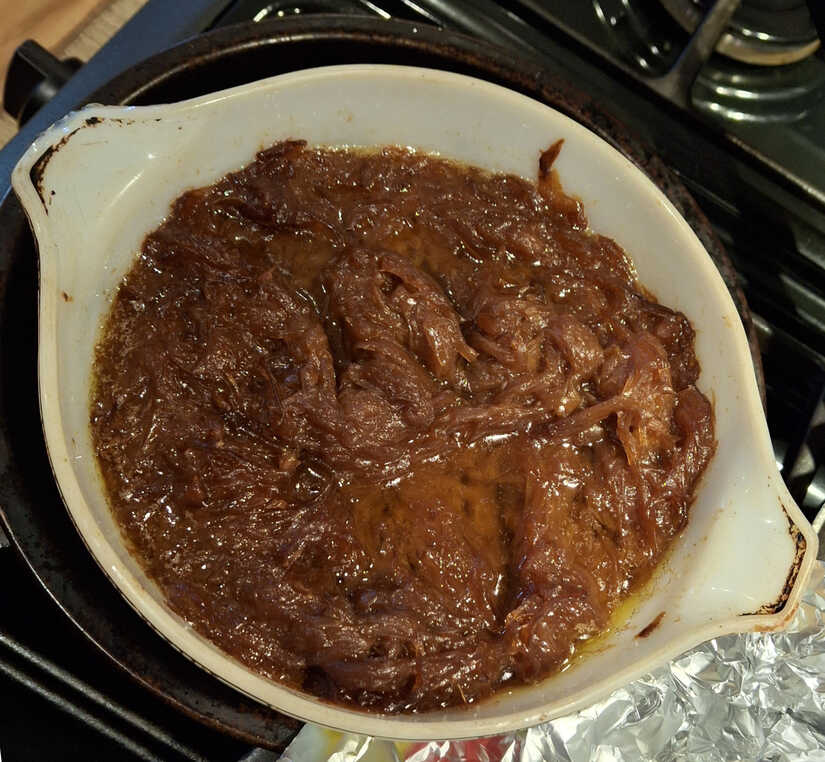
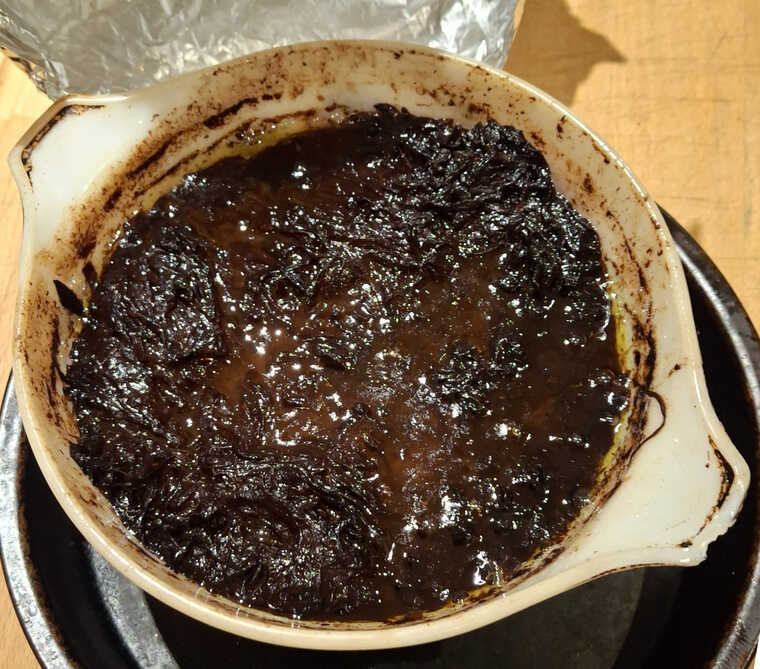
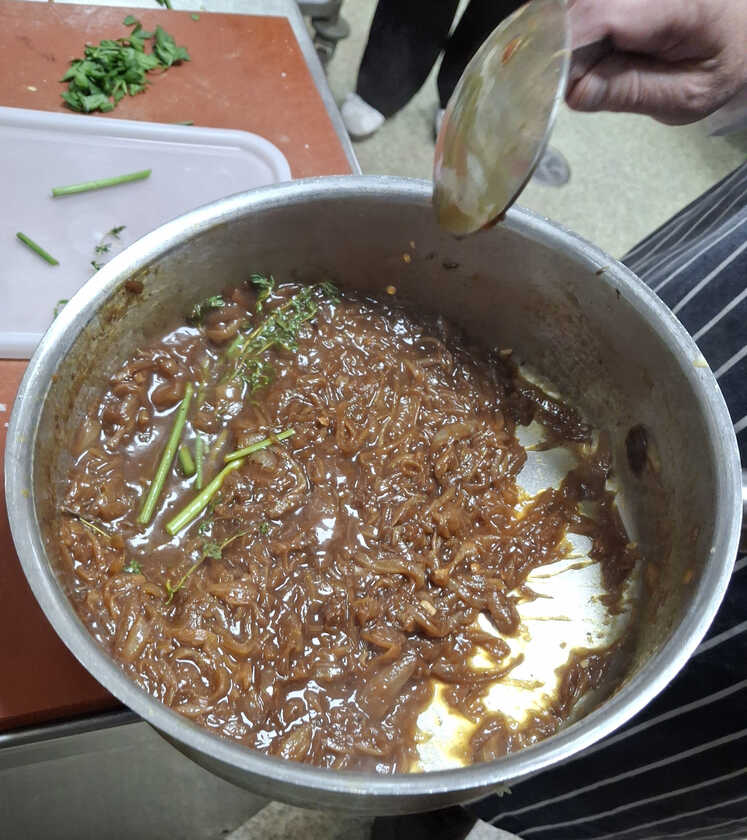
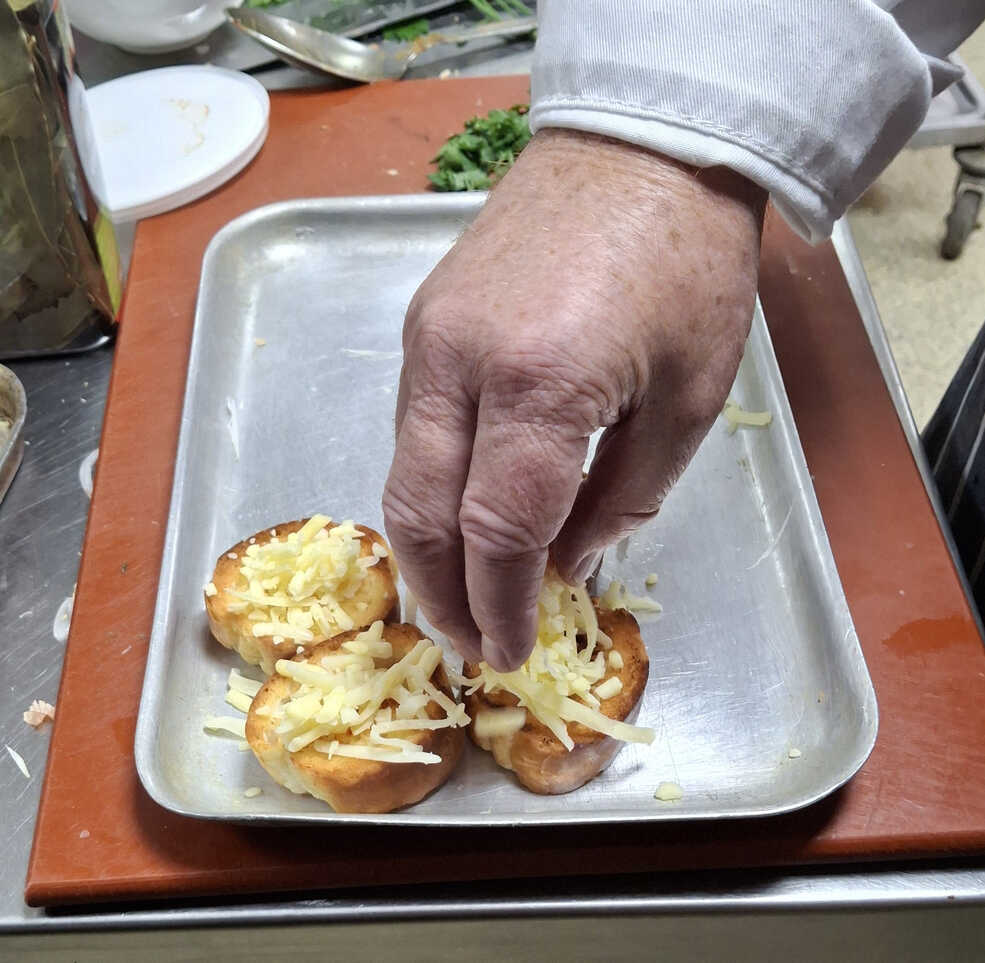
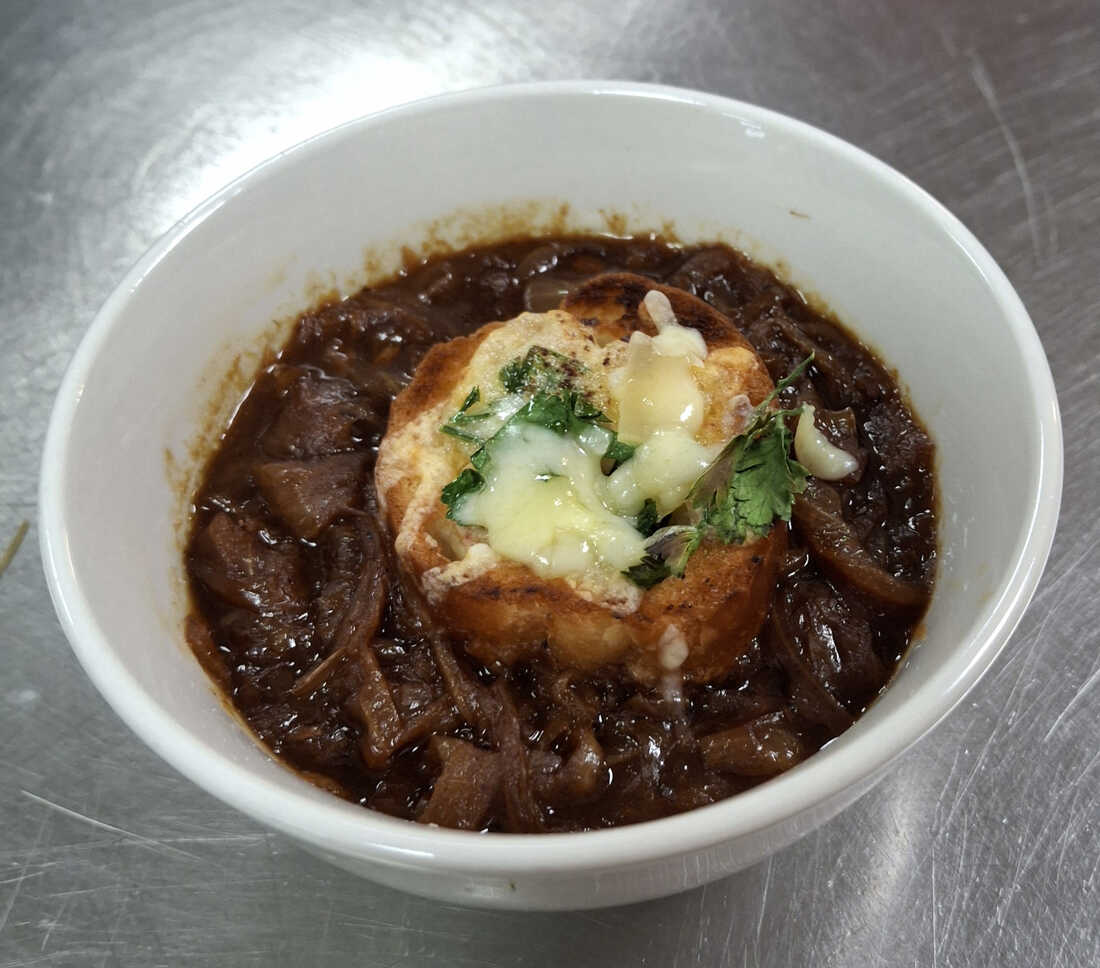
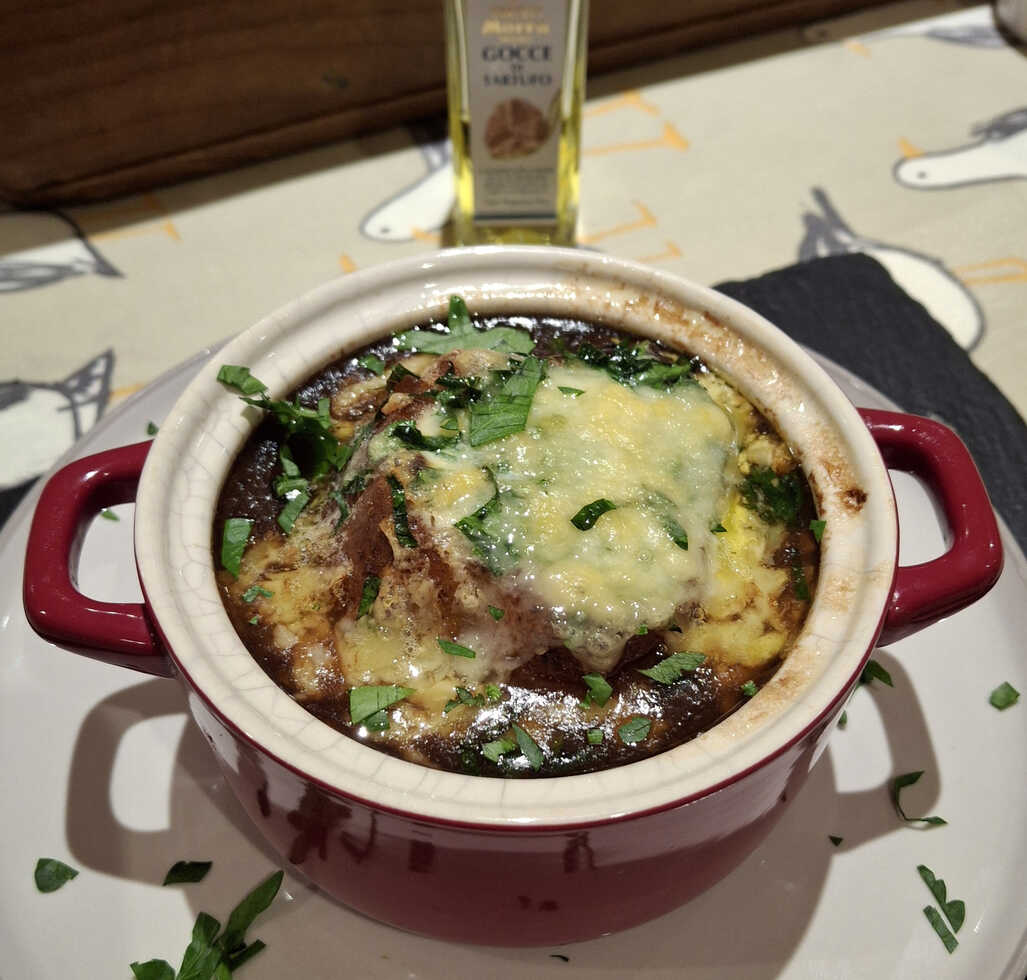
FIGHT! FIGHT! FIGHT!